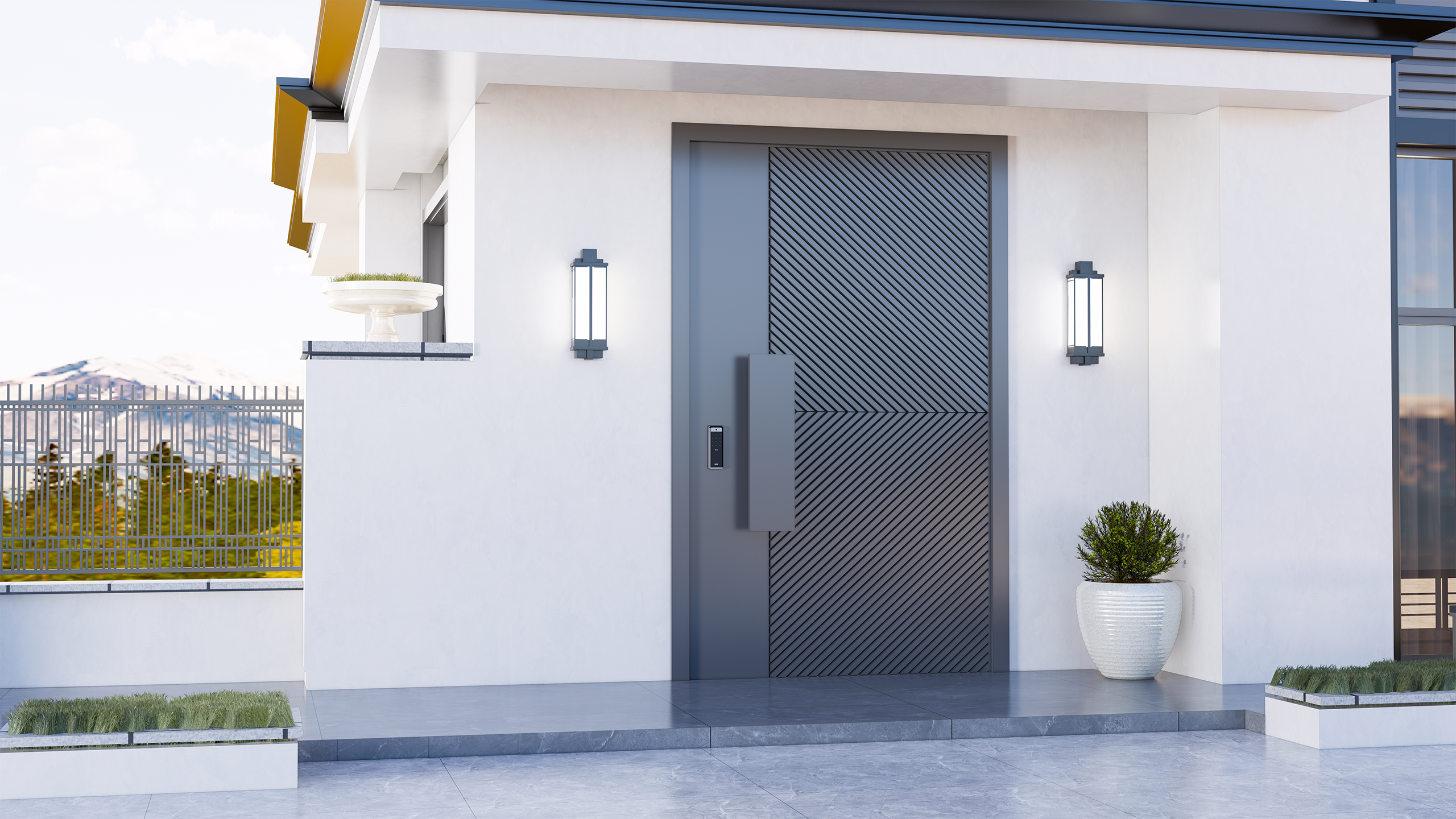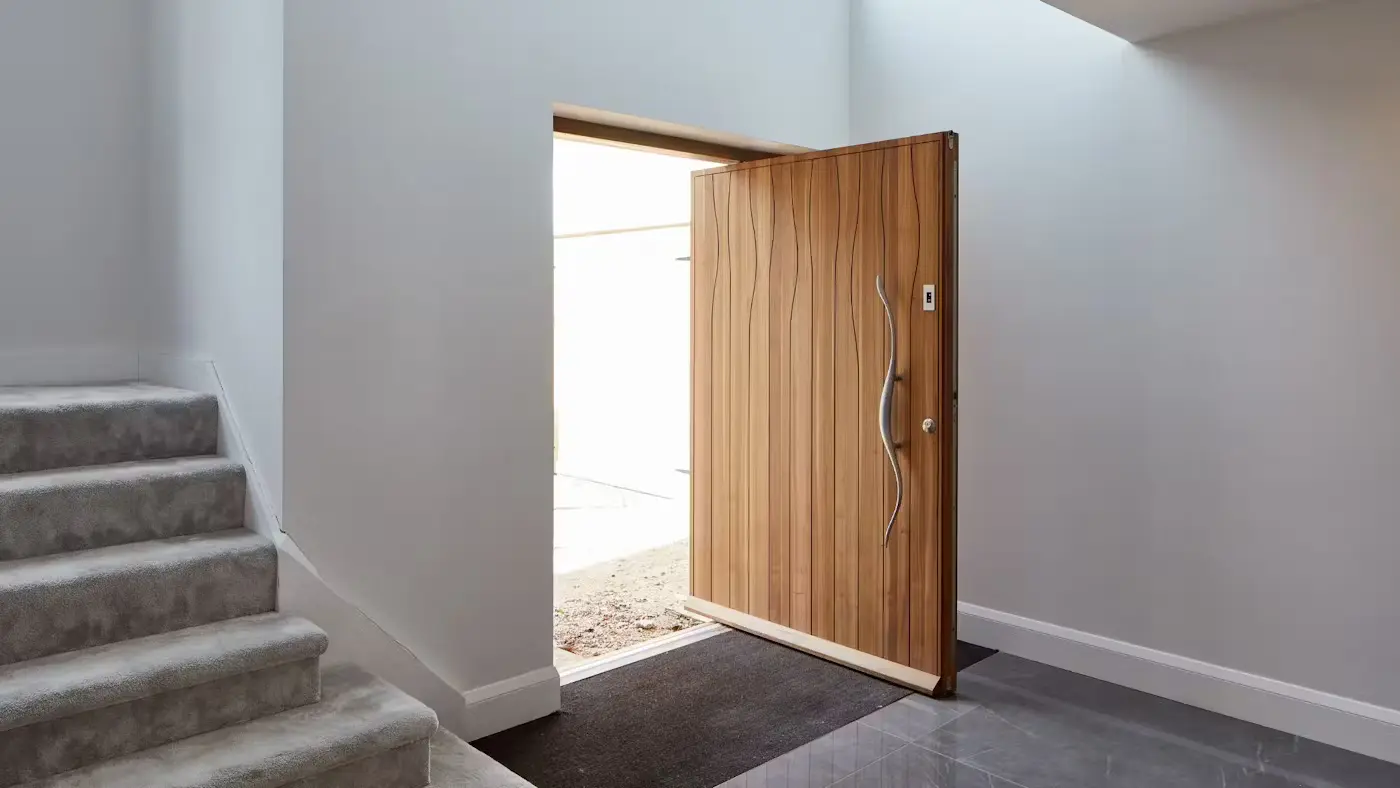What is the front door of a house?

What is a Front Door?
A front door is more than just an entryway into your home. It’s the first thing people notice when they approach your house, and it plays a huge role in both the style and security of your home. Whether it’s sleek and modern or rustic and traditional, the exterior door sets the tone for the entire house. But its importance goes beyond looks—this door is essential for privacy, security, and energy efficiency.
Brief Definition of A Front Door
Simply put, the front door is the main entry point to a home. It’s often the most prominent door in a house and usually faces the street or the yard. While most people immediately think of the front door as the large wooden or metal door with a handle, there are many variations, such as glass doors, French doors, and sliding doors. Essentially, it is the exterior door that allows you to enter and exit your home.
The front door doesn’t just serve as a practical feature. It’s also a part of your home’s exterior design, reflecting your style and setting a welcoming tone for visitors. Whether it’s a classic wooden panel or a high-tech smart door, your front door plays a role in how your home is perceived from the outside.
Importance in Overall Home Design and Safety
When it comes to home design, the exterior door is one of the first elements that people see. It has the power to create a strong impression, making it a critical element in your home’s curb appeal. A well-chosen front door can enhance the overall aesthetic of your property, while a poorly chosen one can detract from it.
Not only is the front door important for design, but it also plays a crucial role in home security. A sturdy, well-constructed exterior door is your first line of defense against intruders. It acts as a barrier, protecting your home and family from outside threats. Features such as solid locks, deadbolts, and reinforced materials contribute to its security.
The front door also helps regulate the climate inside your home. A high-quality door can keep the cold out in winter and the heat out in summer, thereby improving your home’s energy efficiency. Additionally, it provides privacy, blocking the view from the outside while offering a safe, private entrance.
The Role of the Front Door in Home Aesthetics
Your front door plays a pivotal role in your home’s overall aesthetic. It is often the first thing that visitors notice, making it an essential element in setting the tone of your home. Whether you’re aiming for a welcoming look or a bold, modern statement, the exterior door plays a key role in shaping how your home is perceived from the outside.
How the Front Door Sets the Tone for Your Home?
When you think about the exterior of your home, the front door is the focal point that draws the eye. It’s the exterior door that welcomes guests, invites passersby to take a closer look, and sets the tone for the first impression of your space. The right front door design can reveal a great deal about your style and the atmosphere you want to create within your home.
If you have a traditional or rustic home, a classic wooden exterior door with intricate carvings or a warm, natural finish will complement the cozy, inviting feel of your space. On the other hand, if you own a modern or minimalist home, a sleek, solid front door with clean lines and a neutral color palette will enhance the simplicity and elegance of your property.
The front door can also be a standout feature when you choose bold colors or unique hardware. A bright red or deep blue exterior door can create a striking contrast with the rest of your home’s exterior, drawing attention and adding a touch of personality. Conversely, a more neutral tone, such as charcoal gray or classic white, can offer a timeless and sophisticated look.
Front Door Designs for Every Home Style
No matter your home’s architectural style, there’s a front door design to match. Whether you’re working with a traditional, contemporary, or farmhouse style, the exterior door can enhance the look and feel of your property.
Traditional Homes:
For more classic homes, wooden front doors with ornate detailing, such as carvings or paneling, can offer a warm and inviting look. These doors are often paired with elegant, brass hardware to complete the traditional feel. If you’re looking to add a bit of charm, consider front doors with glass inserts or sidelights, which allow natural light to flow into the entryway.
Modern Homes:
If your home boasts sleek lines and clean design, opt for a front door that reflects that simplicity. Solid, smooth exterior doors in neutral shades, such as black, white, or gray, complement the modern aesthetic perfectly. Materials like fiberglass or steel are also popular in modern designs for their durability and sleek appearance. Glass front doors or those with large glass panels can provide a modern, open look while still offering privacy.
Farmhouse Homes:
For a cozy, rustic charm, consider a wooden front door with a natural finish. Farmhouse-style doors often feature elements such as a barn-door aesthetic or decorative hardware that add character and warmth. A front door with a large glass window or a combination of wood and metal details can create an inviting entrance that feels down-to-earth and welcoming.
Craftsman and Bungalow Homes:
These homes typically feature detailed, handcrafted elements. A front door made from rich wood, with built-in sidelights and stained glass accents, can help achieve that perfect handcrafted feel. The design often includes bold, geometric patterns, making it a statement piece in the overall entryway.
Summary
Regardless of the style your home follows, the front door plays a crucial role in unifying the exterior elements. It can either blend seamlessly with your home’s architectural theme or stand out as a feature that draws attention. The right design, whether it’s a classic wooden door or a sleek, modern steel door, will elevate your home’s curb appeal.
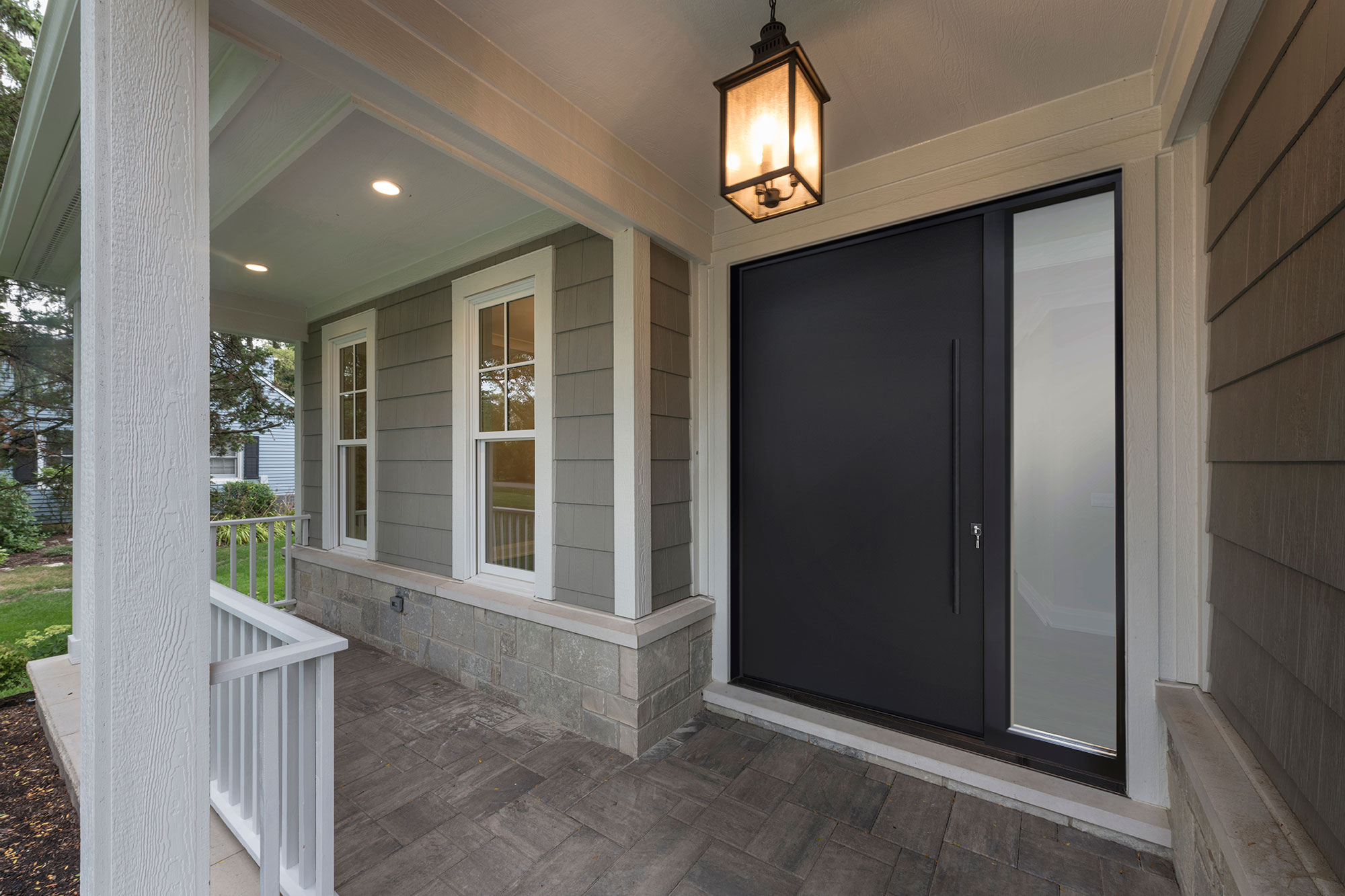
The Practical Function of the Front Door
While the front door is a key element in home aesthetics, it also serves important practical purposes. It serves as the primary entryway into your home, providing a layer of protection from the outside world. In addition to its aesthetic appeal, the exterior door plays a vital role in ensuring ease of access and safety. Let’s explore how it functions on a day-to-day basis.
Front Door as an Entryway
The front door is the primary access point to your home. It serves as the exterior door that people use to enter and exit, setting the tone for the overall flow and functionality of the space. When it comes to entryways, the front door often features additional elements, such as handles, locks, and sometimes even a porch or landing area that leads into the house.
Think about how your front door fits with the rest of your home’s design. For example, double doors might be an elegant choice for larger homes, creating a grand entrance, while a single door may be perfect for smaller spaces, offering a more intimate and cozy feel. Some homes may also feature front doors with sidelights (windows on the sides of the door) or transom windows (a small window above the door), which allow more natural light to enter the hallway or entryway.
Additionally, the front door often serves as a space for practical features, such as a mail slot, door knocker, or even a small storage area. These small details can make your exterior door more functional, helping with daily tasks such as receiving mail or providing a place to hang a coat or bag before entering the house.
Security Features of a Front Door
The front door is your home’s first line of defense, providing both physical security and peace of mind. As the most exposed and often the most used entry point, it is crucial that your exterior door offers the proper security features.
When it comes to the security of your home, the front door should be made of strong, durable materials that are resistant to break-ins. Many homeowners opt for solid wood doors, fiberglass doors, or steel doors, all of which are known for their durability and strength. These materials help prevent unauthorized access, as they are more resistant to breakage or damage than lighter doors.
Locks are another essential part of front door security. A deadbolt is a must-have on any exterior door, as it provides a much higher level of protection than a standard latch lock. Some front doors also come with additional locking mechanisms such as multi-point locks, which secure the door at multiple points, making it more difficult for intruders to break in.
For added security, many homeowners are turning to smart front doors that come equipped with keyless entry systems, video doorbells, and smart locks. These features enable you to monitor and control access to your home remotely. For instance, a video doorbell lets you see who is at the door before answering, even if you’re not home. Smart locks, on the other hand, allow you to unlock the door using your phone, eliminating the need for traditional keys.
Additionally, a front door with a peephole or security camera can give you a better view of the outside and increase safety, especially if you’re not expecting visitors. Exterior doors with a security screen can also provide a layer of protection, allowing you to keep the door open for ventilation while still keeping out unwanted guests.
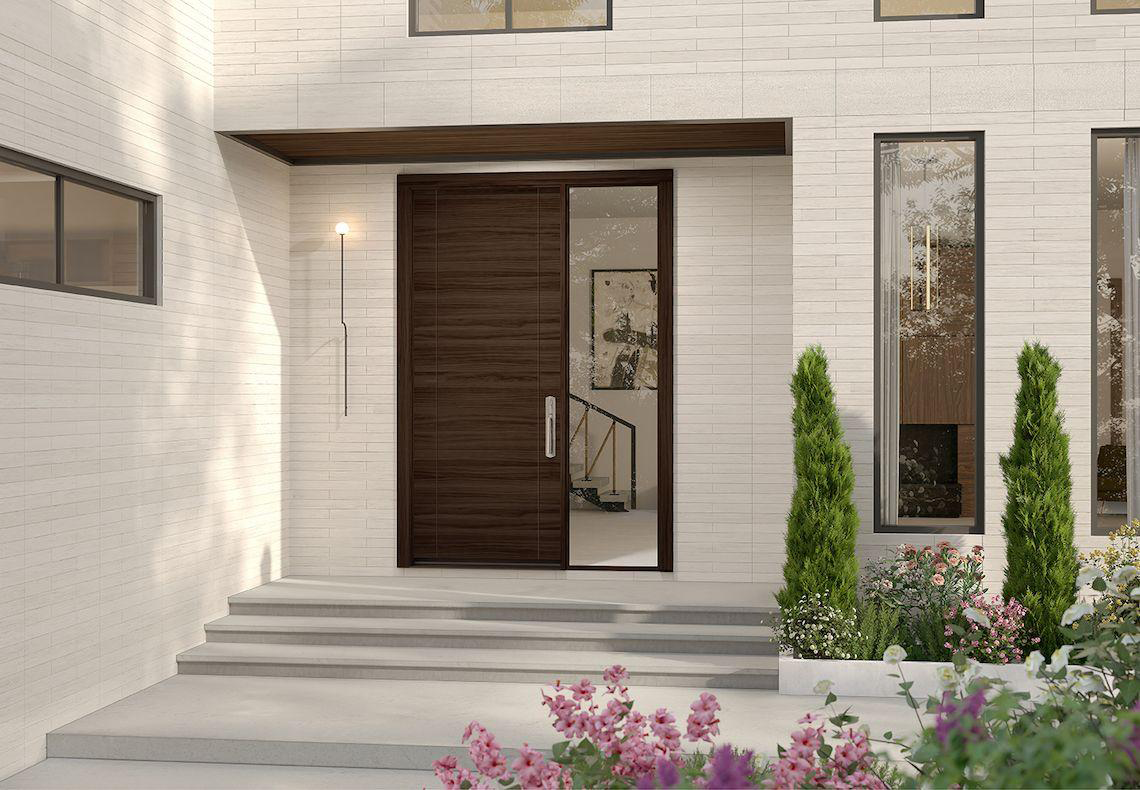
Materials Used in Front Door Construction
Choosing the right material for your front door is essential for both its functionality and appearance. Whether you want a traditional wooden look or a sleek modern design, the material you select will impact the door’s durability, security, and energy efficiency. The exterior door you choose should not only suit your style but also provide long-lasting protection.
Best Materials for Durability and Security
When it comes to exterior doors, durability and security are top priorities. Some materials are better suited to withstand the elements and provide a solid barrier against potential break-ins. Here are a few materials known for their strength:
Steel Doors:
Steel front doors are one of the best options when security and durability are top concerns. They are incredibly strong and can resist impact, making them a great choice for protecting your home. Steel is also low-maintenance and provides a high level of energy efficiency, helping to keep your home insulated. Many steel doors also come with reinforced security features, such as multi-point locking systems, making them even more secure.
Cast Aluminum Doors:
Cast aluminum exterior doors are gaining popularity due to their strength and lightweight nature. These doors are highly durable and resistant to corrosion, making them a great choice for homes in areas with high humidity or coastal climates. They are also low-maintenance and can withstand harsh weather conditions without losing their appearance. Cast aluminum doors provide excellent security and energy efficiency, offering a solid barrier while helping to regulate your home’s temperature.
Solid Wood Doors:
For a more traditional look, solid wood front doors are a popular choice. Wood offers natural beauty and can be custom-designed to fit your home’s aesthetic. When properly maintained, wood is durable and can provide a strong barrier against the elements. However, wood doors require regular maintenance, such as sealing and repainting, to protect them from rot and other forms of damage.
The Pros and Cons of Popular Door Materials
Each material has its strengths and weaknesses. To help you choose the best exterior door for your needs, here’s a look at the pros and cons of some of the most common door materials:
Steel Doors
Pros: Extremely secure and durable, resistant to wear and tear, requires minimal maintenance, offers excellent energy efficiency, and often comes with reinforced locking mechanisms.
Cons: Can be more expensive than other materials, susceptible to dents if impacted, and limited aesthetic options compared to wood or cast aluminum.
Cast Aluminum Doors
Pros: Lightweight, resistant to corrosion, low maintenance, weather-resistant, excellent security, and energy efficiency.
Cons: It can be more expensive than fiberglass, may lack the warmth and aesthetic appeal of wood, and is more prone to dents and scratches than steel.
Solid Wood Doors
Pros: Timeless beauty and elegance, customizable designs, provides excellent insulation, can be repaired and refinished.
Cons: Requires regular maintenance to prevent rotting, warping, and fading, can be expensive, and is not as secure as steel or cast aluminum.
Summary
Choosing the right exterior door material depends on your priorities—whether it’s security, maintenance, or style. Steel doors offer top-tier security, while cast aluminum doors strike a balance between durability and a lightweight design. Wooden doors offer a classic charm but require more upkeep, and composite doors combine the best features of multiple materials.
Choosing the Right Front Door for Your Home
Selecting the right front door is a big decision. It affects the appearance of your home, its security, and the overall comfort of your living space. A carefully chosen exterior door can complement your home’s design, enhance curb appeal, and provide the protection you need. Let’s delve into the factors that will help you select the ideal front door and explore how you can personalize it to suit your home.
Factors to Consider Before Buying a Front Door
Before choosing an exterior door, consider several key factors to ensure it meets both your aesthetic and practical needs. Here’s a breakdown of what you should keep in mind:
Style and Design:
Think about the architectural style of your home. A traditional wooden door looks great on a cottage-style house, while a modern steel front door suits a minimalist, contemporary home. Make sure the front door aligns with the overall look and feel of your house. You can choose from various designs, including single doors, double doors, French doors, or doors with sidelights and transom windows to enhance the look of your entryway.
Material:
The material used for the exterior door will impact its durability, security, and energy efficiency. If you’re looking for security and longevity, steel doors are an excellent choice. For a more classic, timeless appearance, wooden doors are great but require more maintenance. If you’re looking for a low-maintenance yet strong and stylish option, cast aluminum doors are a great choice. Also, consider the energy efficiency of the material, as a well-insulated door can help you save on heating and cooling costs.
Size and Fit:
Make sure the front door fits perfectly in your entryway. Measure the height and width of the existing doorframe to ensure a proper fit. If your entryway is unusually large, you may want to consider installing double doors or custom-sized options to fill the space effectively. A door that’s too small or too large can affect both the aesthetics and functionality of your home.
Security Features:
Your front door is the first line of defense against intruders. Ensure that you choose a door with solid locks, such as deadbolts or smart locks, and consider a door with reinforced panels for added security. Cast aluminum and steel doors are excellent options when security is a priority, as they are sturdy and more resistant to break-ins.
Weather Resistance:
Depending on your location, you’ll want a front door that can withstand the local weather conditions. In areas with extreme heat or cold, energy-efficient doors with good insulation can help maintain a comfortable home temperature. Additionally, consider materials such as fiberglass or cast aluminum, which are highly resistant to the elements and won’t warp or crack over time.

Front Door Customization: Tailoring Your Door to Your Home
Once you’ve considered the basic factors, you can move on to customizing your front door to make it truly your own. Exterior doors offer numerous options for personalization, ranging from color to hardware. Here’s how you can tailor your front door to suit your home perfectly:
Color and Finish:
The color of your front door plays a huge role in your home’s curb appeal. Bold colors, such as red, blue, or yellow, can make a statement, while neutral shades like black, white, or gray offer a timeless look. You can also experiment with different finishes, such as matte, glossy, or textured, to match your home’s exterior. Don’t forget that certain colors, such as red, are known to symbolize warmth and welcome, while darker shades may convey a more elegant or dramatic look.
Glass Inserts:
Adding glass panels or sidelights to your exterior door can make your entryway feel more open and inviting. Choose from clear, frosted, or decorative glass, depending on your preferred level of privacy. You can also add a transom window above the door for added elegance and natural light.
Hardware and Accessories:
The hardware you choose for your front door can make a big impact. Consider adding a stylish door handle, knocker, or a modern smart doorbell. You could also consider custom door hinges or unique lock designs to add a personal touch. Many homeowners also add a welcome mat or custom house number to enhance the overall look.
Energy Efficiency:
If you live in an area with extreme weather, consider customizing your front door to enhance energy efficiency. Insulated doors or those with weatherstripping can help reduce energy loss. Some exterior doors even come with built-in energy-efficient glass that blocks heat and cold, making your home more comfortable and lowering your utility bills.
Style Elements:
Depending on your style preference, you can choose from a variety of elements to make your front door stand out. For instance, you can go for decorative ironwork, etched glass designs, or a custom frame. Adding accents like clavos (decorative nails) to a wooden door can give it a rustic, Mediterranean feel, while a sleek, minimalist design works well in modern homes.
Front Door Maintenance and Care
Your front door is constantly exposed to the elements, from the harsh rays of the sun to the cold winds and rain. Regular maintenance and care are essential to ensure it stays looking great and functioning properly. Proper upkeep will not only extend the life of your exterior door but also help maintain the security and energy efficiency of your home. Here’s how you can take care of your front door to keep it in top shape.
How to Maintain and Protect Your Front Door?
Taking care of your front door is relatively simple but requires consistency. Here are some easy steps you can follow to maintain and protect your exterior door:
Clean Regularly:
Dust, dirt, and grime can accumulate on your front door, so cleaning it regularly is important. Use a soft cloth or sponge with warm, soapy water to wipe down the door. For wooden doors, avoid using harsh chemicals that can damage the finish. For steel or cast aluminum doors, you can use a mild cleaner to remove stains. Clean the hardware, including the handles and locks, as well, to prevent dirt buildup that might cause them to become stiff or nonfunctional.
Seal and Repaint Wooden Doors:
Wooden front doors require extra care to maintain their beauty and durability. Over time, wood can absorb moisture, causing it to warp or rot. To prevent this, apply a fresh coat of paint or varnish every 1-2 years, depending on your local climate. This will help seal the wood and protect it from the elements. When you do this, make sure to lightly sand the surface before reapplying the paint or varnish for a smooth, even finish.
Check for Gaps and Air Leaks:
Inspect your front door for any gaps that could allow air to leak through. If you notice drafts or a rise in your heating or cooling bills, you might have an issue with the door’s seal. Weatherstripping is a simple and inexpensive fix to prevent air from escaping. Adding a door sweep at the bottom of the door is another effective way to block drafts and maintain your home’s insulation.
Lubricate Moving Parts:
Whether it’s a wooden, steel, or composite front door, any moving parts, such as the hinges and locks, need to be lubricated to prevent rust and ensure smooth operation. Use a silicone-based lubricant to keep your door functioning properly. This will help prevent squeaks and ensure that the door opens and closes easily.
Protect from the Elements:
If your front door is exposed to harsh sunlight or heavy rain, it can take a toll on its appearance. You can protect it by installing an overhang or awning above the door, which will shield it from direct exposure. This is especially helpful for wooden and painted doors, which can fade or deteriorate more quickly in the sun.

Common Front Door Issues and How to Fix Them
Even with proper care, your front door may develop issues over time. Here are some common problems you might encounter with your exterior door, along with solutions for fixing them:
Warping or Swelling (Wooden Doors):
Over time, wooden front doors can absorb moisture, causing them to warp or swell. This is common in areas with high humidity or temperature fluctuations. If you notice that your door is sticking or doesn’t close properly, it may have swollen. To fix this, try sanding down the affected area and reapplying a protective finish coat. If the problem persists, consider replacing the door or installing a composite door that is less susceptible to swelling.
Scratches or Dents (Steel and Aluminum Doors):
Steel and cast aluminum doors are durable, but they can still get scratched or dented, especially if they are accidentally hit or exposed to harsh conditions. For small scratches, you can use a touch-up paint or a specialized door repair kit. For dents, you might need to replace the damaged panel, or if it’s minor, a professional can often repair it by smoothing out the dent and repainting.
Loose or Broken Hardware:
Over time, the handles, locks, or hinges on your front door may become loose or malfunction. Tighten screws as needed to secure the hardware. If the lock is no longer functioning properly, you can either clean it or replace the entire mechanism. On the other hand, if the hinges are loose, use a screwdriver to tighten them. If necessary, replace the hinge altogether to ensure the door continues to open and close smoothly.
Drafts or Air Leaks (All Types of Doors):
If you feel a draft around your front door, the weatherstripping has likely worn out, or the door has shifted out of alignment. To fix this, inspect the weatherstripping and replace any damaged sections. Also, check the door sweep at the bottom to ensure it seals the gap properly. If the door is misaligned, adjust the hinges or frame to make sure the door closes tightly.
Rust on Metal Doors:
Steel doors are prone to rust if they aren’t properly sealed or maintained. If you spot rust on your exterior door, scrub it gently with a wire brush or sandpaper to remove the rust, then repaint the area with a rust-resistant paint. Regularly inspect metal doors for early signs of rust to prevent it from spreading.
Summary
Regular maintenance and quick fixes will keep your front door in great shape for years to come. By addressing small issues before they become big problems, you can prolong the life of your exterior door and maintain its security, beauty, and functionality.
Relate FAQ
How do I choose the right front door for my home?
Choosing the right front door involves considering several factors:
- Style: Match the door's design with the architectural style of your home (modern, traditional, rustic, etc.).
- Security: Opt for a solid door with strong locks and good build quality.
- Insulation: Consider energy-efficient doors to maintain comfort and reduce heating/cooling costs.
- Material: Choose a material that aligns with your security needs, aesthetic preferences, and budget.
- Budget: Front doors come in a wide price range, so select one that fits within your budget while meeting your needs.
Can I replace my front door myself?
Replacing a front door can be a DIY project if you're comfortable with basic carpentry and have the proper tools. However, it's recommended to hire a professional if you're unsure, especially if the door frame or hardware needs to be adjusted. A properly installed door ensures security, insulation, and smooth operation.
How often should a front door be replaced?
The lifespan of a front door depends on its material and maintenance. On average, a well-maintained front door can last anywhere from 20 to 30 years. If you notice issues such as sagging, difficulty closing, or draftiness, it might be time to consider a replacement.
How can I improve the security of my front door?
To improve the security of your front door, consider the following upgrades:
- Install a solid-core door: Choose a door that is sturdy and resistant to forced entry.
- Upgrade locks: Use deadbolts and smart locks for added protection.
- Add a peephole or security camera: This lets you see who's outside without opening the door.
- Reinforce the door frame: A reinforced frame adds extra security, making it harder to break the door down.
What is the most secure type of front door?
Steel doors are often considered the most secure option for front doors. They offer high durability, are resistant to impact, and provide excellent protection against forced entry. Steel doors are also energy-efficient and can be customized with various finishes to suit the style of your home.
Can a front door impact home energy efficiency?
Yes, the front door plays an important role in a home's energy efficiency. A poorly insulated or damaged door can lead to heat loss in the winter and air conditioning loss in the summer, increasing energy bills. Upgrading to an energy-efficient front door made of insulated materials, like fiberglass, can help maintain indoor temperatures and lower energy costs.
